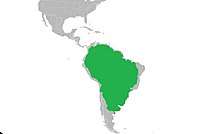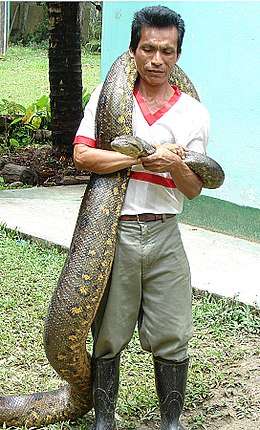Anaconda
| Anaconda Temporal range: Miocene-recent[1] | |
|---|---|
| Green anaconda, Eunectes murinus | |
| Scientific classification | |
| Kingdom: | Animalia |
| Phylum: | Chordata |
| Class: | Reptilia |
| Order: | Squamata |
| Suborder: | Serpentes |
| Family: | Boidae |
| Subfamily: | Boinae |
| Genus: | Eunectes Wagler |
 | |
| Range of Eunectes | |
| Synonyms | |
| |
Anacondas are a group of large snakes of the genus Eunectes. They are found in tropical South America. Four species are currently recognized.
Description
Although the name applies to a group of snakes, it is often used to refer only to one species in particular, the common or green anaconda (Eunectes murinus) which is the largest snake in the world by weight, and the second longest.
Etymology
The South American names anacauchoa and anacaona were suggested in an account by Peter Martyr d'Anghiera but the idea of a South American origin was questioned by Henry Walter Bates who, in his travels in South America, failed to find any similar name in use. The word anaconda is derived from the name of a snake from Ceylon (Sri Lanka) that John Ray described in Latin in his Synopsis Methodica Animalium (1693) as serpens indicus bubalinus anacandaia zeylonibus, ides bubalorum aliorumque jumentorum membra conterens.[2] Ray used a catalogue of snakes from the Leyden museum supplied by Dr. Tancred Robinson, but the description of its habit was based on Andreas Cleyer who in 1684 described a gigantic snake that crushed large animals by coiling and crushing their bones.[3] Henry Yule in his Hobson-Jobson notes that the word became more popular due to a piece of fiction published in 1768 in the Scots Magazine by a certain R. Edwin. Edwin described a 'tiger' being crushed and killed by an anaconda, when in fact tigers never occurred in Sri Lanka.[lower-alpha 1] Yule and Frank Wall noted that the snake was in fact a python and suggested a Tamil origin anai-kondra meaning elephant killer.[5] A Sinhalese origin was also suggested by Donald Ferguson who pointed out that the word Henakandaya (hena lightning/large and kanda stem/trunk) was used in Sri Lanka for the small whip snake (Ahaetulla pulverulenta)[6] and somehow got misapplied to the python before myths were created.[7][8][9]
The name commonly used for the anaconda in Brazil is sucuri, sucuriju or sucuriuba.[10]

Species and other uses of the term "anaconda"
The term "anaconda" has been used to refer to:

- Any member of the genus Eunectes, a group of large, aquatic snakes found in South America:
- Eunectes murinus, the green anaconda – the largest species, found east of the Andes in Colombia, Venezuela, the Guianas, Ecuador, Peru, Bolivia, Brazil and Trinidad and Tobago
- Eunectes notaeus, the yellow anaconda – a small species, found in eastern Bolivia, southern Brazil, Paraguay and northeastern Argentina
- Eunectes deschauenseei, the darkly-spotted anaconda – a rare species, found in northeastern Brazil and coastal French Guiana
- Eunectes beniensis, the Bolivian anaconda – the most recently defined species, found in the Departments of Beni and Pando in Bolivia
- The giant anaconda, a mythical snake of enormous proportions said to be found in South America
- The term was previously applied imprecisely, indicating any large snake that constricts its prey,[11] though this usage is now archaic.
See also
- South American jaguar, a competitor or predator
Notes
References
- ↑ Hsiou, Annie S.; Albino, Adriana M. (2009). "Presence of the Genus Eunectes (Serpentes, Boidae) in the Neogene of Southwestern Amazonia, Brazil". Journal of Herpetology. 43 (4): 612. doi:10.1670/08-295.1.
- ↑ Ray, John (1693). Synopsis methodica animalium quadrupedum et serpentini generis. London: Impensis S. Smith & B. Walford. p. 332.
- ↑ Owen, Charles (1742). An essay towards a natural history of serpents. p. 114.
- ↑ Pocock, R. I. (1930). "The Panthers and Ounces of Asia". Journal of the Bombay Natural History Society. 34 (2): 197–336.
- ↑ Wall, Frank (1921). Ophidia Taprobanica or the Snakes of Ceylon. Ceylon: Government Press. p. 48.
- ↑ Willey, A (1904). "Some rare snakes of Ceylon". Spolia Zeylanica. 1: 81–89.
- ↑ Ferguson, Donald (1897). "The derivation of "Anaconda"". Notes and Queries. 12: 123–124.
- ↑ Skeat, Walter W. (1882). A concise etymological dictionary of the English Language. Oxford University Press. p. 16.
- ↑ Yule, Henry; Burnell, A.C. (1903). Hobson-Jobson. London: John Murray. pp. 24–25.
- ↑ "Dicionário online de português: sucuriju". Retrieved 19 February 2014.
- ↑ Oxford. 1991. The Compact Oxford English Dictionary. Second Edition. Clarendon Press, Oxford. ISBN 0-19-861258-3.
| Wikisource has the text of the 1920 Encyclopedia Americana article Anaconda. |
| Wikimedia Commons has media related to Eunectes. |
| Look up anaconda in Wiktionary, the free dictionary. |
Further reading
- Ray J. 1693. Synopsis methodica animalium quadrupedum et serpentini generis. Vulgarium natas characteristicas, rariorum descriptiones integras exhibens: cum historiis & observationibus anatomicis perquam curiosis. Præmittuntur nonnulla de animalium in genere, sensu, generatione, divisione, &c. - pp. [1-14], 1-336, [1-9]. Londini. (Smith & Walford).
- Yule H, Burnell AC. 1886. Hobson-Jobson: A Glossary of Colloquial Anglo-Indian Words and Phrases, and of Kindred terms, Etymological, Historical, Geographical, and Discursive. London: J. Murray. pp. 133–134. (reprinted in 1903 by W. Crooke).